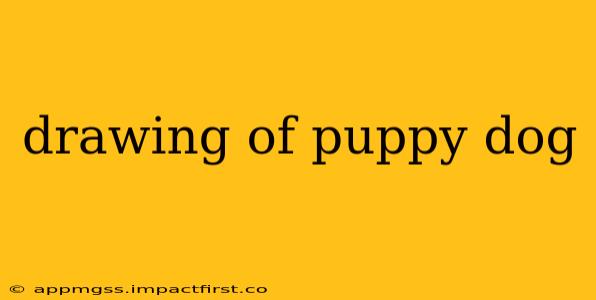Drawing a Puppy Dog: A Step-by-Step Guide for Beginners and Beyond
Drawing a puppy dog can be a fun and rewarding experience, regardless of your skill level. This guide will walk you through the process, from basic shapes to adding adorable details, catering to both beginners and those looking to refine their skills. We'll cover various techniques and styles, ensuring you can create the perfect puppy portrait.
What supplies do I need to draw a puppy?
This depends on your preferred medium! For a classic approach, you'll need:
- Pencils: A range of pencils (e.g., HB, 2B, 4B) will allow for varying line weights and shading. A hard pencil (like an HB) is good for light sketching, while softer pencils (like 2B or 4B) create darker lines and shading.
- Eraser: A kneaded eraser is ideal as it can be molded to erase precisely. A standard eraser will also work.
- Paper: Use drawing paper suitable for your chosen medium. Thicker paper prevents smudging and tearing.
- Optional: Colored pencils, crayons, markers, or paints for adding color and depth.
What are the basic shapes of a puppy?
Before diving into intricate details, it's helpful to break down the puppy's form into basic shapes. Think of the body as a slightly elongated oval or circle, the head as a circle, and the legs as cylinders. This simplified approach makes it easier to build upon.
How do I draw a puppy's face?
The face is where the personality shines! Begin with two circles for the eyes, placed slightly below the center of the head. Add smaller circles inside for highlights. Then, draw a small triangle or upside-down "V" for the nose, and a curved line for the mouth. Add floppy ears—two rounded shapes—on either side of the head. Experiment with different ear shapes for diverse puppy breeds!
How do I draw puppy legs and paws?
Draw four cylinders for the legs, tapering slightly towards the paws. The paws themselves can be simplified as small ovals or bean shapes. Remember to consider the puppy's posture—are they sitting, standing, or lying down? This will affect the angle and position of the legs.
How can I add details to make my puppy drawing look realistic?
Once you have the basic shapes, start adding details! This is where you can bring your puppy to life. Consider these points:
- Fur: Use short, light strokes to suggest fur texture. Vary the pressure on your pencil to create depth and dimension.
- Shading: Use shading to create volume and form. Identify where light would naturally hit the puppy's body and leave those areas lighter. Darken the areas away from the light source.
- Expression: The eyes are crucial for expressing personality. Slightly raised eyebrows can convey happiness, while downturned ones can suggest sadness.
What are some different styles I can use to draw a puppy?
You're not limited to a single style! Experiment with different approaches:
- Cartoon Style: This involves simplified shapes and exaggerated features for a playful effect.
- Realistic Style: This requires more attention to detail, accurate anatomy, and realistic shading.
- Impressionistic Style: Focus on capturing the overall impression of the puppy rather than precise details.
How do I add color to my puppy drawing?
Once your pencil sketch is complete, you can add color using your preferred medium. Remember to layer colors gently for a smoother finish. Consider using lighter shades first, and gradually building up the color intensity.
Drawing a puppy is an iterative process. Don't be afraid to experiment, make mistakes, and erase! The more you practice, the better you'll become. Have fun and let your creativity shine!
